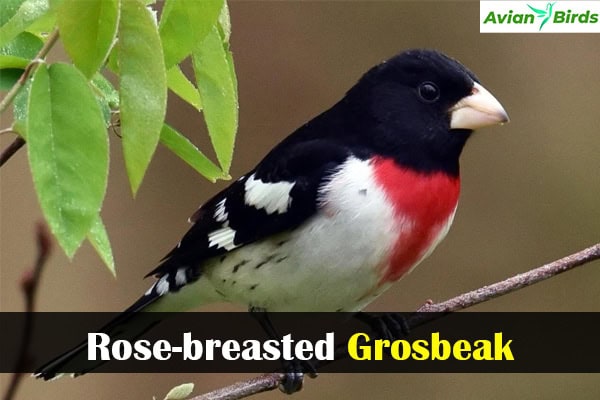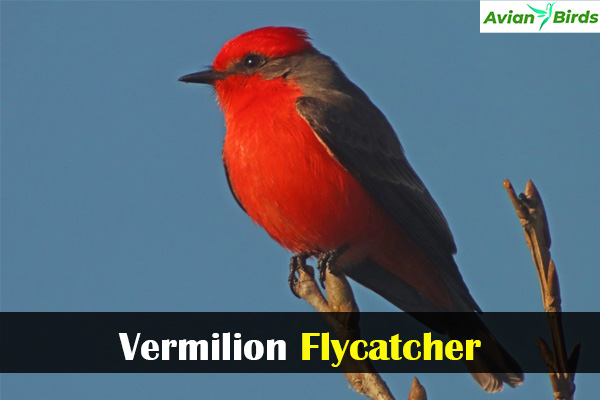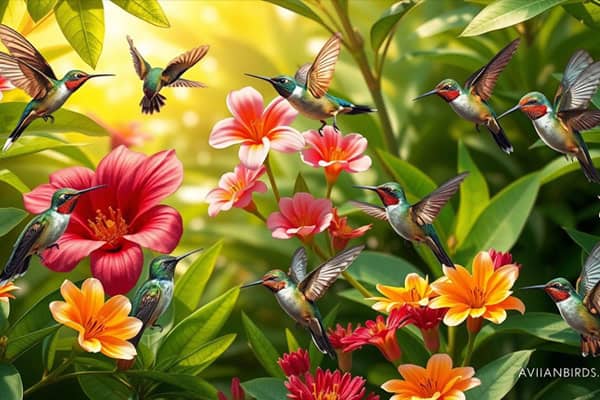15 Types of Birds With Red Chests (ID Guide With Pictures)
Do you know that over 15 birds species with bright red chests live in North America? These birds can be found in forests and even in our backyards. They are a delight for birdwatchers and photographers.
Learning about these birds helps us enjoy watching them more and makes it easier to tell them apart. Let’s discover the beauty of these red-breasted birds together!
Introduction to Birds With Red Chests
Birds with red chests catch our eye with their bright beauty. They have striking red feathers and live in many places in North America, often seen in forest edges and scrublands. Red is a rare color in birds, but it makes us love wildlife more.
The American Robin is a well-known bird with a red chest commonly seen in gardens and parks. The Northern Cardinal is also famous for its red chest. They have different ways of living and adapting to their homes. Their bright colors help them find mates or mark their territory.
In this section, we’ll learn more about birds with red chests. We’ll discuss where they live, how they behave, and why they’re important. Knowing more about these birds helps us connect with nature and its colorful creatures, including various red-breasted birds.
| Bird Species | Red Plumage Description | Habitat |
|---|---|---|
| American Robin | Orange-red chest and grayish-brown upper parts | Gardens, parks, and open woodlands |
| Northern Cardinal | Vivid red plumage with a distinctive crest | Thickets, shrublands, and woodlands |
| Rose-breasted Grosbeak | Black head and back with a rose-colored chest | Deciduous forests and shrubby areas |
Why Do Birds Have Red Chests?
The red chest of many birds is key to their survival and finding mates. This bright colour helps males attract females. Females choose males with bright colours because they show the health and strong genes.
Red chests also help birds recognize each other. This is vital for social life, including finding mates and setting up territories. It’s a way for birds to communicate visually.
Red chests can also warn off predators. Bright colours can mean the bird is toxic or not tasty. This helps birds stay safe and healthy in their homes.
| Species | Length | Habitat | Distinctive Colors |
|---|---|---|---|
| European Robin | 5.3 inches | Woods, Parks, and Wooded Countryside in the world of birds in Europe and Asia | Olive-green Upper Body, Orange-colored Breast |
| American Robin | 10 inches | Cities and Woods Across North America | Brown Upper Plumage, Brick Red Breast |
| Belted Kingfisher | Size varies among species, including medium-sized birds with red chests. varies | Widespread Near Bodies of Water in North America | Various Colors, Notable for Blue and White |
| Barn Swallow | Size varies | Widespread in Various Habitats Across North America | Shiny Blue and Red Coloring |
| Red-breasted Nuthatch | Size varies | Coniferous Forests Across North America | Red Breast and Blue-grey Plumage |
1. Scarlet Tanager
The Scarlet Tanager catches the eye with its bright colors and special habits, which are characteristic of many male birds. The male scarlet tanager is known for its bright red feathers during breeding season. These medium-sized birds live in large forests in eastern North America and move to Central America for the winter to survive.

Breeding Plumage and Habitat
In breeding season, male scarlet tanagers have deep red bodies and black wings and tails. Their bright colors help them attract mates and hide in the trees. They love mature deciduous forests and need big, untouched areas to live.
Diet of Redstart Species and Behavior
Scarlet tanagers mainly eat insects in the summer and fruits in winter to help them migrate. They have unique songs, with males singing loudly and females singing softly. It’s hard to see them because they stay high in the trees, but their songs help us find them.
| Attribute | Details about the breeding behavior and habitats of these fascinating songbirds. |
|---|---|
| Breeding Plumage | Bright red body with black wings and tail |
| Migratory behaviour can be observed in birds with a red chest as they travel between habitats. | Migrating to Central America in winter is a behavior observed in many songbirds. |
| Habitat | Deciduous forests, sensitive to fragmentation |
| Diet | Primarily insects; also fruits in winter |
| Song Characteristic of male birds in the songbird category of many avian species, this bird showcases unique traits.s | Burry, rising and falling series of notes |
2. House Finch
The house finch is a delightful bird with charming traits. Knowing how to identify them makes us appreciate the beauty of red-breasted birds more. They live in many places, from urban parks to backyard feeders, and can often be seen in forest edges.

Identification and Variation
Male house finches https://en.wikipedia.org/wiki/Red-breasted_sapsuckerare known for their bright colours. They can be pale yellow or bright red, with red being common. Females are brown with blurry streaks, making it easy to tell them apart.
Habitat and Diet
House finches live in many places. They like open and desert areas, as well as cities and suburbs. They avoid dense forests.
They eat mostly plants, such as seeds, buds, and berries, typical of red-breasted birds. They feed the young seeds they’ve swallowed. Bird feeders are a favorite spot for them. A feeder with black oil sunflower seeds will attract many birds with a red chest, including the American Robin.
| Feature | Males | Females |
|---|---|---|
| Color | Bright red, with variations | Brown, with blurry streaks |
| Habitat | Urban areas, deserts, grasslands | Urban areas, open woods |
| Diet | Seeds, buds, and berries are commonly eaten by birds, particularly those with a white rump. | Seeds, buds, berries |
| Breeding Behavior of Redstart Species | Monogamous tends food | Incubates eggs |
Watching their habits teaches us about their resilience. They are a wonderful species to enjoy in our daily lives.
3. Rose-breasted Grosbeak
The rose-breasted grosbeak is a stunning bird known for its bright colors and sweet song. It’s interesting to learn about the differences between males and females.
Males vs. Females
The rose-breasted grosbeak’s males and females look very different. Males have a red stripe on their chest, surrounded by black and white. Females have brown feathers with white stripes and a light stripe over their eyes.

This difference helps us tell them apart. It also influences their behavior and interactions.
Breeding Range and Feeding Habits
These birds live in the northeastern U.S., southern Canada, and Baja California in the summer. They move to Central America for the winter, which shows how wide their breeding range is.
Rose-breasted grosbeaks eat a variety of foods, such as seeds, fruits, and insects, making them versatile foraging birds. They love visiting bird feeders for sunflower seeds, safflower seeds, and raw peanuts. Their varied diet helps them survive in different places, making them a joy to have around.
| Characteristics | Males | Females |
|---|---|---|
| Coloration plays a significant role in attracting mates, particularly in birds with a red chest. | This black-and-white bird with red chevron is a striking example of the diverse plumage found in avian species. | Brown and heavily streaked |
| Size | Medium-sized, larger than House Finch | Medium-sized, smaller than males, these birds with a red chest exhibit sexual dimorphism. |
| Feeding Preferences | Seeds, fruits, and insects | Seeds, fruits, and insects |
| Breeding Behavior | Incubates eggs for several hours | Incubates eggs primarily at night |
4. Scarlet Macaw
The scarlet macaw stands out with its bright colors, similar to other avian wonders found in tropical forests. It has a stunning look and a lively personality. Its bright red body and blue and yellow feathers make it very recognizable.

Distinct Features and Habitat
The scarlet macaw has amazing features, including its vibrant red underparts. It’s big, up to 33 inches long, and has long tail feathers. Its strong beak is great for cracking nuts and seeds.
These birds come to live in many places. They like the forests of Central and Northern South America. They need many trees and water for food, such as fruits, seeds, and flowers.
| Feature | Details |
|---|---|
| Colouration | Bold scarlet body with blue and yellow accents |
| Size | Up to 33 inches in length |
| Habitat | Woodlands, forests, and areas near water |
| Diet | Fruits, seeds, flowers, and nectar |
5. Red-breasted Meadowlark
The red-breasted meadowlark is a bird that catches the eye. Its bright red chest against a black body and happy song make it a joy to see in nature.

Appearance and Habitat Preferences
This bird is about 19 cm (7.5 in) long and weighs 40 to 48 g (1.4 to 1.7 oz). Its red chest and dark wings make it stand out among other red-plumaged birds. It loves open places to live.
It lives in open fields and grasslands in southern and northern Central America. It eats insects and seeds. Its range extends from southwestern Costa Rica to northeastern Peru and central Brazil.
According to IUCN 3.1, the red-breasted meadowlark is not in danger, making it one of the avian wonders of North America. It lays two to four eggs that are reddish-brown-blotched cream. These birds are strong and help keep their ecosystems balanced.
| Characteristic | Details |
|---|---|
| Appearance | Bright red chest, predominantly black body |
| Average Length | 19 cm (7.5 in) |
| Weight Range | 40–48 g (1.4–1.7 oz) |
| Clutch Size | Two to four reddish brown-blotched cream eggs |
| Geographical Distribution shows that these birds can be found across various regions, including the eastern United States. | South-western Costa Rica to north-eastern Peru, and central Brazil |
| First Sighting in Nicaragua | 2008 |
| Conservation Status | Least Concern (IUCN 3.1) |
The red-breasted meadowlark means joy, renewal, and good luck in many cultures. It connects us to nature. It reminds us to be strong and find balance in life.
6. Vermilion Flycatcher
The Vermilion Flycatcher is a bird that catches the eye. Adult males have bright red and black feathers. They show off orange-red on their belly. Females and young birds have gray-brown feathers with a hint of salmon-red.
These birds come to live in many places. They like open areas like scrub, deserts, and fields. They sit on branches, watching for insects to eat. They fly fast to catch their food and then return to the same spot.

Male Vermilion Flycatchers are about 5 to 5.5 inches long. They have a wingspan of 9.4 to 9.8 inches. They weigh between 0.39 and 0.49 ounces. They are found in Mexico, the southwestern United States, and parts of South America.
Female Vermilion Flycatchers lay two or three eggs at a time. They might also lay eggs in other birds’ nests. Males have affairs while staying with one female, showing complex mating habits.
Learning about the Vermilion Flycatcher reveals the beauty of birds. Their bright red color and ability to adapt make them interesting to watch. We can help protect their homes and learn more about them.
| Characteristic | Male | Female |
|---|---|---|
| Coloration | Brilliant red and black | Gray-brown with faint streaks |
| Weight | 11-14 g (0.39-0.49 oz) | 11-14 g (0.39-0.49 oz) |
| Length | 5.1-5.5 in (13-14 cm) | 5.1-5.5 in (13-14 cm) |
| Primary Diet | Flies, bees, grasshoppers, crickets, beetles | Flies, bees, grasshoppers, crickets, beetles |
| Inhabited Habitats | Open scrub, deserts, weedy fields | Open scrub, deserts, weedy fields |
7. Scarlet-breasted Flowerpecker
The scarlet-breasted flowerpecker is one of 48 types in the flowerpecker family, a notable group within the bird world. It is known for its bright features and special ways of acting. Its bright red chest and throat stand out against its black body.
It is small, about 9 cm (3.5 inches) long, and weighs 5.3 to 7.5 grams. This size allows it to move easily through Southeast Asia’s forests, especially in New Guinea and nearby islands.

Physical Characteristics and Distribution
The scarlet-breasted flowerpecker’s pretty looks help it live in its home. There are 11 different kinds, showing its variety. These birds live up to 1500 meters high in forest tops, edges, and gardens.
| Characteristic | Details |
|---|---|
| Size | Approximately 9 cm |
| Weight | 5.3 – 7.5 grams |
| Breeding Cycle | 2 – 3 white eggs laid |
| Diet | Fruits, large seeds, spiders, nectar, and pollen |
| Vocalization | Buzzing “bszzrt” sound |
| Habitat | Canopy and upper forest levels |
This bird is important in its home. It eats many fruits and helps plants grow, which supports the avian ecosystem. It lives in New Guinea and on islands like Saibai and Boigu. Knowing where and what this bird looks like helps us see the world’s diversity.
8. Red-breasted Sapsucker
The red-breasted sapsucker is a woodpecker known for its bright red head and chest. It lives in forests and orchards in western North America and visits suburban areas in winter.
There are two types of red-breasted sapsuckers: the rubber, which lives in Alaska and Oregon, and the daggetti, which lives in Oregon and California.

The rubber has more red on its body. The dagger is smaller and has a white stripe. Both have black and white backs and white sides. Their bellies are yellowish.
In summer, they nest in trees like aspen, 50 to 60 feet above the ground. They lay 5 to 6 eggs and take turns feeding their young.
The young leave the nest after 23 to 29 days. They stay with their parents for another ten days.
They eat tree sap by drilling into trees, which attracts insects. We can see them in Sacramento from September to March.
They are common in western Washington but rare in the east. Their calls sound like ‘mew’ or ‘nasal squealing’, making them easy to identify among the many birds to spot. They are beautiful and important for nature.
9. Northern Cardinal
The northern cardinal is a favorite bird in North America. Its bright red color, especially in male birds, catches the eye. Its songs add beauty to places like backyards and parks. Watching its behavior makes birdwatching even more fun.

Sightings and Behavior
Male northern cardinals have a bright red colour with black faces. Females are less flashy, with pale brown and soft red. They sing together, sounding like “cheer, cheer, cheer.” This singing is heard all year, even in winter.
These birds are common in yards, parks, and woodlots. They like to stay low in shrubs and trees. They often come in pairs, making birdwatching more charming. Adult males use their strong bill to get seeds from shells.
In winter, Riverside Park in Cambridge is a great place to seehttps://en.wikipedia.org/wiki/Red-breasted_sapsucker them. They join other birds, like American Tree Sparrows and Mourning Doves, to find food, showing teamwork in survival.
The northern cardinal is easy to spot in many places. Many people see them for the first time at Riverside Park, where both young and old enjoy their beauty.
10. Summer Tanager
The summer tanager is a Birds With Red Chests that catches the eye with its bright colours and sweet song. Adult males are a vibrant red, standing out in their green surroundings. Females and young males have a yellow-green colour, adding variety to the species.
We often see summer tanagers in mature forests, especially near open areas. They live in the southeastern and southwestern United States and northern Mexico, making them a common sight for bird watchers in the eastern United States. These birds are medium-sized with a chunky build. They like to perch high in the trees, singing a song that sounds like an American Robin’s call.

Both males and females make a unique sound, often saying pit-ti-tuck. They eat insects, helping the environment. Their ability to migrate shows their strength and beauty.
Conclusion
As we wrap up our guide on birds with red chests, it’s clear they are both beautiful and diverse. We’ve seen birds like the Scarlet Tanager and the House Finch. These birds not only catch our eye but also teach us about nature.
Bird watching allows us to see their amazing behaviours and homes, helping us connect more with the world around us.
Our journey shows how important each bird is to our planet. Birds like the American Robin face many challenges. But they are crucial to our ecosystems.
By watching and appreciating these birds, we can help our planet and learn to better care for our world.
We invite all bird lovers to go out and explore. Use this guide to find these amazing birds. Let’s enjoy nature and help protect these beautiful creatures.
Read More🐦Related Articles:
| African Fish Eagle: All You Need to Know |
| HAWKS IN TENNESSEE |
| Types of Flamingo |
| Mesmerizing World of Rosy Starling |
| Common Ostrich (Struthio camelus) |
Frequently Asked Questions
Q1. What is a bird with a red chest?
A common bird with a red chest is the American Robin, known for its bright red-orange belly.
Q2. What kind of bird has a red puffy chest?
The male House Finch often has a puffy red chest, especially during mating season.
Q3. What bird has a red chest patch?
The Red-breasted Nuthatch has a distinctive reddish-orange chest patch.
Q4. What kind of bird has a red stomach?
The Rose-breasted Grosbeak has a striking red patch on its chest that extends down toward the stomach.







